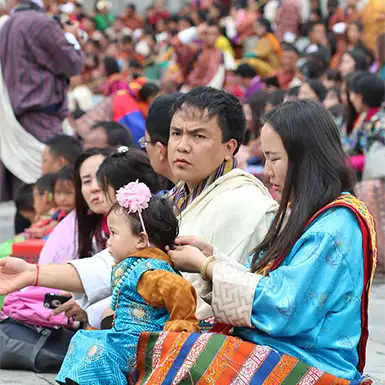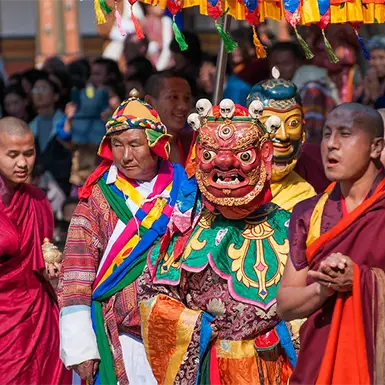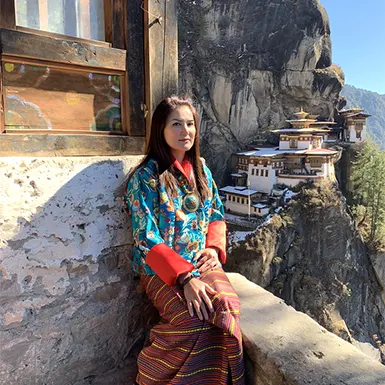Based on 6 reviews

Paro Tshechu Festival Tour 2026
Experience Bhutan's vibrant heritage at the Paro Tshechu Festival Tour
Duration
Meals
- 6 Breakfast
- 6 Lunch
- 6 Dinner
Accommodation
- Paro – Bhutan Mandala or similar
- Thimphu – Hotel Amodhara or similar
- Punakha – Hotel Pema Karl or similar
Activities
- Festival Observation
- Sightseeing
- Scenic Drive
SAVE
US$ 590Price Starts From
US$ 2950
Overview of Paro Tshechu Festival Tour 2026
Indulge in an extraordinary journey with our exclusive Paro Tshechu Festival Tour, exploring Bhutan’s rich cultural tapestry. This meticulously crafted 7-day itinerary promises an immersive experience centered around the renowned Paro Tshechu festival, a vibrant celebration of Bhutanese heritage and spirituality. Upon arrival in Paro, a traditional Bhutanese welcome greets guests, setting the tone for an enchanting adventure. The itinerary seamlessly blends cultural encounters, scenic wonders, and festival revelry to create an unparalleled travel experience.
- Paro Tshechu Spectacle: Immerse yourself in the vibrant pageantry of the Paro Tshechu festival, where traditional masked dances and symbolic rituals unfold against the historical backdrop of Paro Dzong.
- Tiger’s Nest Odyssey: Start a breathtaking hike to the iconic Taktsang Monastery, perched dramatically on a cliff, offering awe-inspiring views of the Paro Valley.
- Cultural Encounters in Thimphu: Explore Thimphu’s bustling markets and cultural landmarks, including the Memorial Chorten and the majestic Buddha Dordenma Statue.
- Punakha’s Serenity: Discover the tranquility of Punakha Valley as you visit the Dochula Pass and the historic Punakha Dzong, nestled at the confluence of two rivers.
- Warm Bhutanese Hospitality: Experience the genuine warmth of Bhutanese hospitality as you engage with locals, savor traditional cuisine, and participate in optional activities like archery lessons and hot stone baths.
The heart of this tour lies in the two days dedicated to the Paro Tshechu festival Tour. Attendees will witness the mesmerizing spectacle of traditional masked dances, symbolic rituals, and vibrant cultural performances. As the festival unfolds against the backdrop of Paro Dzong, the ancient fortress steeped in history, participants find themselves immersed in the spirit of Bhutanese traditions. The atmosphere is palpable with joy and devotion, providing a unique opportunity to engage with the local community and forge lasting memories.
Beyond the festival, our itinerary unveils the scenic splendors of Bhutan. Every destination offers a new facet of Bhutanese beauty, from the iconic Tiger’s Nest Monastery perched dramatically on a cliff in Paro to the bustling markets of Thimphu and the serene Punakha Valley. Enjoy the warmth of Bhutanese hospitality, savor local cuisine, explore ancient fortresses, and enjoy the breathtaking landscapes. The Paro Tshechu Festival Tour is a harmonious blend of cultural immersion and natural wonders, promising an unforgettable vacation in the mystical realm of Bhutan.
Detail Itinerary of Paro Tshechu Festival Tour 2026
Day 1: Arrival in Paro
Traditional Welcome: Arrive at Paro International Airport for a warm Bhutanese welcome, setting the tone for an immersive cultural experience.
Transfer to Hotel: Transfer to your hotel in Paro, offering a chance to rest or explore the local surroundings at your leisure.
Evening Relaxation: Enjoy a peaceful evening, acclimating to the Bhutanese atmosphere, perhaps taking a stroll in the charming town of Paro.
Meals: Dinner
Paro – Bhutan Mandala or similar
Day 2: Explore Paro
Paro Dzong Visit: Begin the day with a visit to Paro Dzong, a fortress with rich historical and cultural significance. Explore its intricate architecture and learn about its role in Bhutanese history.
Taktsang Monastery Hike: Afternoon hike to the iconic Taktsang Monastery (Tiger’s Nest) – a spiritual haven perched on a cliff. Revel in panoramic views of the Paro Valley as you absorb the spiritual ambiance of this sacred site.
Evening at Leisure: Evening at leisure to unwind, reflect on the day’s experiences, or engage with fellow travelers. Optionally, partake in a cultural program or enjoy the serene surroundings.
Meals: Breakfast, Lunch, and Dinner
Paro – Bhutan Mandala or similar
Day 3: Paro Tshechu Festival
Festival Inauguration: Immerse yourself in the grandeur of the Paro Tshechu Festival. Witness the inauguration with vibrant processions, traditional dances, and intricate costumes, offering a glimpse into Bhutanese culture and spirituality.
Masked Dances: Attend traditional masked dances depicting mythological stories, a mesmerizing showcase of Bhutanese artistic expression.
Cultural Interaction: Interact with locals, participate in the festivities, and gain insights into the cultural significance of the Tshechu festival. Capture the vibrant atmosphere and create lasting memories.
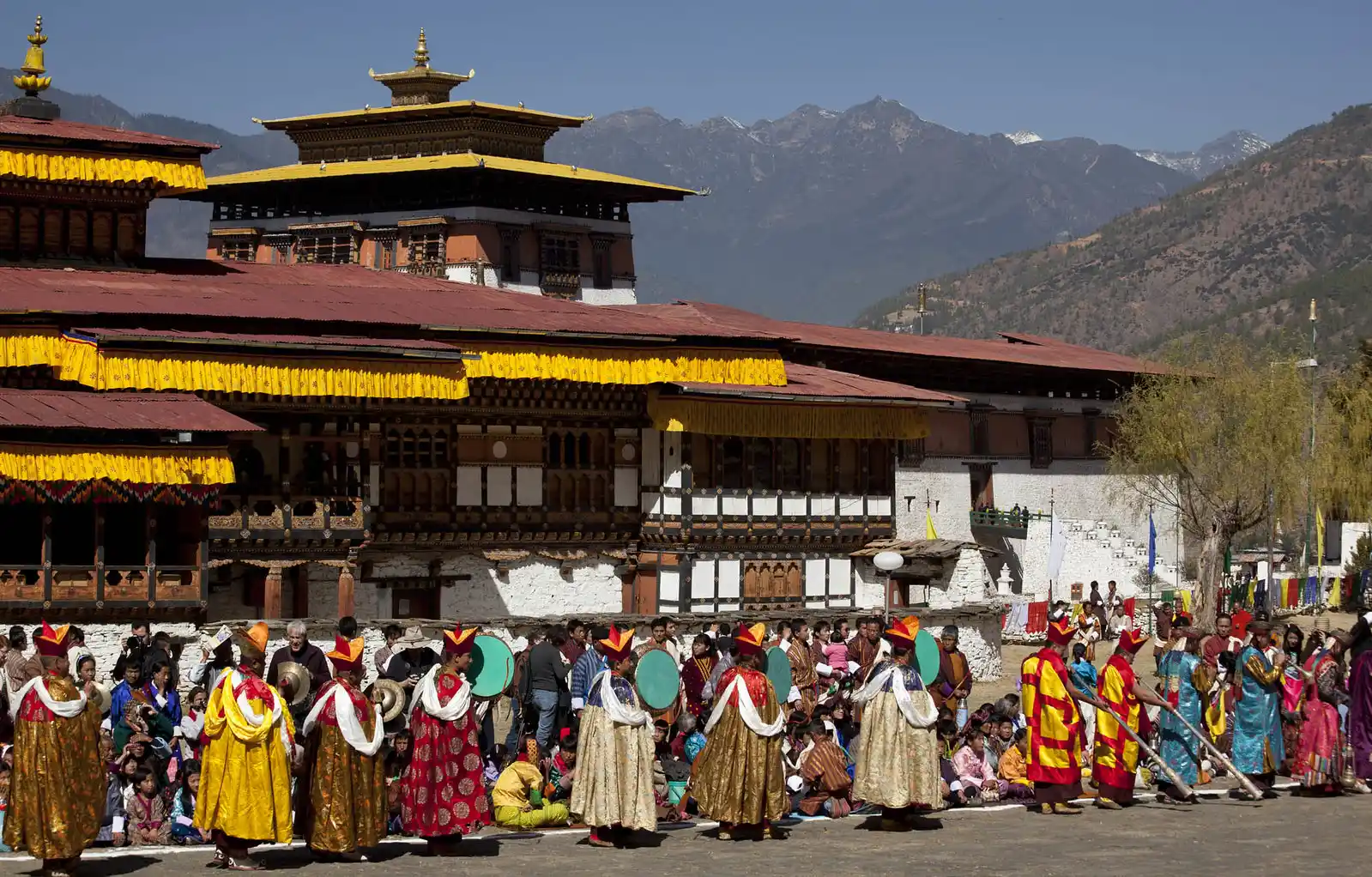
Meals: Breakfast, Lunch, and Dinner
Paro – Bhutan Mandala or similar
Day 4: Thimphu Exploration
Scenic Drive to Thimphu: Depart for Thimphu, the capital city, enjoying a scenic drive through Bhutan’s picturesque landscapes.
Memorial Chorten and Buddha Dordenma Statue: Visit the Memorial Chorten, a sacred monument, and the impressive Buddha Dordenma Statue. Explore the spiritual and cultural facets of Thimphu.
Market Exploration: Stroll through Thimphu’s vibrant markets, offering a chance to shop for traditional Bhutanese handicrafts and immerse yourself in the local lifestyle.
Meals: Breakfast, Lunch, and Dinner
Thimphu – Hotel Amodhara or similar
Day 5: Thimphu to Punakha
Dochula Pass Excursion: Journey to Punakha via the Dochula Pass, relishing panoramic views of the Himalayas. Capture the breathtaking scenery and enjoy a moment of tranquility.
Punakha Dzong Visit: Explore Punakha Dzong, a majestic fortress at the confluence of the Pho Chhu and Mo Chhu rivers. Delve into its history and appreciate its architectural grandeur.
Scenic Punakha Valley: Enjoy a scenic drive through Punakha Valley, known for its lush landscapes and cultural significance—Marvel at the region’s pristine beauty.
Meals: Breakfast, Lunch, and Dinner
Punakha – Hotel Pema Karl or similar
Day 6: Punakha Exploration and Return to Paro
Leisure Morning in Punakha: Begin the day at your own pace, with a leisurely morning to relax amidst Punakha’s serene surroundings or explore the local area independently.
Optional Activities: Choose from optional activities such as a hot stone bath experience in a traditional farmhouse or archery lessons, providing a deeper immersion into Bhutanese traditions.
Punakha Dzong Visit: Revisit Punakha Dzong or explore any areas you missed the previous day. Marvel at the intricate details of this historical fortress.
Scenic Drive Back to Paro: In the afternoon, embark on a scenic drive, allowing you to soak in the beauty of Bhutan’s landscapes again. Enjoy stops along the way for photo opportunities and to relish the journey.
Evening in Paro: Arrive in Paro and check into your hotel. The evening is at leisure, providing an opportunity to unwind or explore Paro’s local attractions.
Meals: Breakfast, Lunch, and Dinner
Paro – Bhutan Mandala or similar
Day 7: Departure from Paro
Bid farewell to the enchanting kingdom of Bhutan as you are transferred to Paro International Airport for your departure. Carry with you the memories of the Paro Tshechu Festival, the cultural wonders, and the warmth of Bhutanese hospitality.
Customize this trip with help from our local travel specialist that matches your interests.
Includes & Excludes
What is included?
- Bhutan Visa
- 3-star hotel accommodation in Paro, Thimphu, and Punakha
- Daily breakfast, Lunch, and Dinner
- English Speaking Tour Guide
- Sightseeing Entrance Fees
- All land transportation
- Applicable Taxes
What is excluded?
- International Airfare and Bhutan Travel Insurance (Travel insurance mandatory)
- Personal Expenses like internet, bar bills, beverages, tipping etc
Departure Dates
We also operate Private Trips.
Trip Information
Introduction to the Paro Tshechu Festival
The Paro Tshechu Festival Tour, among Bhutan’s most revered religious celebrations, is a vibrant testament to this Himalayan kingdom’s rich cultural and spiritual heritage. Held annually in the iconic Paro Dzong, this festival is a focal point for locals and a captivating visitor experience. The festival’s roots trace back to the 17th century when the great Buddhist saint, Guru Rinpoche, is said to have introduced the Tshechu to commemorate the triumph of good over evil. This sacred event unfolds in the picturesque town of Paro, enveloped by the majestic mountains, creating a mesmerizing backdrop for the festivities.
The historical context of the Paro Tshechu deepens its significance, revealing a cultural tapestry woven with the threads of Bhutanese history. The festival traditionally marks the birth anniversary of Guru Rinpoche, also known as Padmasambhava, who played a pivotal role in introducing Buddhism to Bhutan. The colorful masked dances, sacred rituals, and symbolic performances during the Tshechu represent the profound teachings and events associated with Guru Rinpoche’s life. Beyond its religious connotations, the Paro Tshechu is a vibrant expression of Bhutanese identity, fostering community and shared cultural values.
Culturally, the Paro Tshechu is a cornerstone of Bhutanese identity, emphasizing its commitment to preserving its unique traditions. The festival provides a platform for locals to showcase their artistic prowess through intricate dance performances and elaborate costumes. The vibrant and dynamic nature of the festival mirrors the resilience and spirit of the Bhutanese people. Whether locals or international visitors, attendees are immersed in an atmosphere where spirituality and culture intertwine seamlessly, creating an indelible mark on their understanding of Bhutan’s cultural heritage.
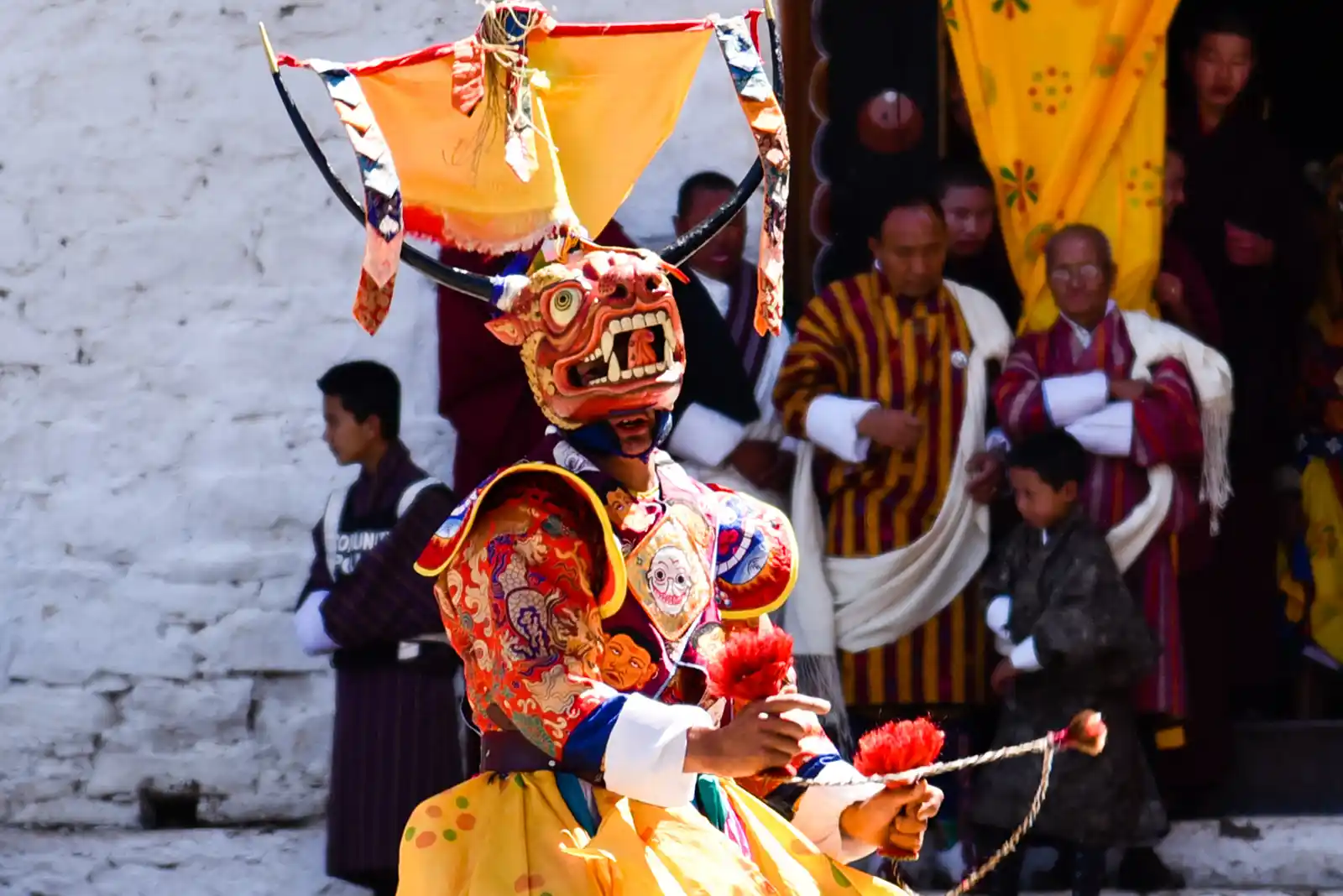
Festival Schedule and Duration
The Paro Tshechu Festival, scheduled for 29 March to 2nd April 2026, unfolds over five days, each meticulously planned to encapsulate diverse cultural and religious events. The festival, hosted in the courtyard of Rinpung Dzong in the picturesque Paro district of Bhutan, offers participants and onlookers a detailed breakdown of its schedule, promising an immersive experience. Commencing with the unfolding of the sacred Thongdrel at dawn, the festival progresses through a series of events, including traditional masked dances, religious rituals, and cultural performances. Each day of the Tshechu is a distinct chapter in the cultural narrative, contributing to the overall richness of the festival experience.
The festival schedule is thoughtfully designed to showcase critical events and ceremonies, allowing attendees to witness the vibrant cultural tapestry of Bhutan. Among the highlights is the Cham dance, a mesmerizing display of choreography by monks adorned in elaborate costumes and masks depicting sacred stories and legends. The courtyard of Rinpung Dzong serves as a majestic backdrop, enhancing each ceremony’s visual and spiritual impact.
From the religious reverence of the unfolding Thongdrel to the joyous celebrations of the local community, the Paro Tshechu unfolds as a harmonious symphony of Bhutanese culture, bringing to life the essence of the nation’s religious and historical significance.
For those attending the Paro Tshechu Festival Tour in 2026, the detailed schedule not only provides a roadmap for the duration of the event but also ensures that participants can strategically plan their days to partake in the various ceremonies and festivities. The festival’s duration and schedule serve as a testament to the meticulous planning and cultural significance attached to each moment, offering a profound and memorable experience for all those fortunate enough to be part of this vibrant celebration in the heart of Bhutan.
Ceremonies and Rituals
The Paro Tshechu Festival unfolds with a rich tapestry of religious ceremonies and rituals that serve as the heartbeat of this cultural extravaganza. Attendees are immersed in a sensory experience as they witness the meticulous execution of these sacred practices, each carrying profound spiritual significance. Among the paramount rituals is the Cham dance, where monks, adorned in vibrant costumes and intricate masks, perform intricate choreography.
This dance visualizes Bhutanese mythology and religious teachings, encapsulating the audience in a mesmerizing display of devotion and artistic expression. As the beats of traditional music reverberate through the air, the atmosphere becomes charged with a sense of reverence, creating a space for spiritual contemplation and cultural appreciation.
The significance of the masked dances extends beyond mere entertainment; each movement tells a story, conveying the essence of Bhutanese Buddhism. The dancers’ intricate masks represent deities, demons, and historical figures, bringing to life the sacred narratives embedded in the country’s cultural fabric. Traditional music played on instruments, such as drums, cymbals, and horns, accompanies these dances, enhancing the immersive nature of the ritualistic performances. Symbolic in nature, these ceremonies connect the present with Bhutan’s ancient past, fostering a deep appreciation for the continuity of cultural traditions. The Paro Tshechu, through its exploration of rites and rituals, offers participants a profound glimpse into the spiritual legacy of Bhutan.
Paro Tshechu Festival Venue
The Paro Tshechu Festival Tour unfolds against the majestic backdrop of the iconic Paro Dzong, serving as a revered venue that amplifies the cultural resonance of this grand celebration. The imposing structure, perched strategically on the banks of the Paro River, offers attendees a visual spectacle that seamlessly blends with the spiritual ambiance of the festival. As the courtyard of Paro Dzong becomes the stage for traditional masked dances and religious ceremonies, participants find themselves surrounded by the architectural splendor and historical aura of this fortification, creating an immersive experience that transcends time and space.
Paro Dzong, also known as Rinpung Dzong, is one of Bhutan’s oldest and most revered fortresses. Its construction in the 15th century was strategically planned to defend the Paro Valley against external threats. The Dzong has witnessed pivotal moments in Bhutanese history, reflecting the nation’s resilience. Its architectural features, characterized by intricate woodwork, towering white walls, and golden roofs, showcase the artistic prowess of Bhutanese craftsmanship.
The religious sanctity of Paro Dzong further enhances the festival’s atmosphere, as participants connect with the spiritual energy embedded in this cultural landmark’s very foundations. With its historical significance and architectural grandeur, the Paro Dzong provides an enchanting setting for the Paro Tshechu, contributing to its unique charm and cultural depth.
Cultural Significance
The Paro Tshechu, a vibrant festival in Bhutan, stands as a testament to the country’s rich cultural heritage. This event, deeply embedded in Bhutanese society, showcases a unique blend of spiritual and cultural practices passed down through generations. It’s more than just a festival; it’s a living, breathing expression of Bhutan’s history and beliefs.
Participants and spectators are immersed in colorful masks, elaborate costumes, and traditional music, each element resonating with historical and spiritual significance. This annual gathering reminds the nation of its deep-rooted values and beliefs, reinforcing the Bhutanese people’s collective identity and spiritual orientation.
Moreover, the Paro Tshechu fosters community cohesion and preserves Bhutan’s ancestral traditions. During the festival, people from various walks of life come together, creating a melting pot of shared experiences and mutual respect. It’s a time when the community bonds over shared rituals and stories, strengthening their connection and heritage. This communal aspect is critical for transmitting customs and oral histories, ensuring these traditions thrive in the modern world. The festival celebrates Bhutan’s past and secures its future as each generation partakes in these age-old traditions, keeping them alive for years.
Traditional Attire and Customs
At the heart of the Paro Tshechu festival in Bhutan lies a remarkable display of traditional attire, a kaleidoscope of colors, and intricate designs that capture the essence of Bhutanese culture. Performers don elaborate costumes that are much more than mere clothing; they are symbols of the rich tapestry of Bhutan’s history and mythology. Often adorned with vibrant patterns and symbolic motifs, these outfits are painstakingly crafted to reflect the various mythical characters and deities in the festival’s dances and stories.
Attendees, too, join this visual spectacle, wearing their finest Ghos and Kiras, traditional Bhutanese dress, which further adds to the festival’s vibrant atmosphere. This sartorial display is not just about aesthetics; it’s a profound expression of respect and honor for their heritage, a way for Bhutanese people to connect with their roots and celebrate their identity.
Alongside the visual feast of traditional attire, the Paro Tshechu is steeped in customs and etiquette that have been carefully preserved over centuries. These customs are integral to the festival, guiding both performers and attendees in a series of rituals and practices that embody the spiritual and communal values of the Bhutanese people. Observances range from specific prayer rituals to interacting with the sacred masked Cham dances.
These etiquettes are not rigid formalities but rather a way to show reverence for the festival’s spiritual nature and maintain a sense of harmony and respect among all participants. This adherence to traditional customs ensures that the festival is a celebration and a means of imparting and sustaining the community’s cultural values and social norms.
Local Involvement and Community Spirit
The Paro Tshechu Festival in Bhutan is a vibrant embodiment of local involvement and community spirit, showcasing an inspiring level of participation from the local populace. Weeks before the festival commences, the streets of Paro buzz with anticipation and activity as community members of all ages come together in a collaborative effort to prepare for the grand event. They engage in various tasks, from decorating the streets and temples to preparing traditional dishes and rehearsing for cultural performances.
This collective preparation is more than just a duty; it’s a cherished opportunity for the locals to contribute to a significant part of their cultural heritage. Such active participation not only ensures the smooth execution of the festival but also reinforces a sense of ownership and pride among the community members as they witness their collective efforts culminate in a magnificent celebration.
Within the heartwarming tapestry of this festival, numerous stories and anecdotes emerge, each highlighting the deep-rooted community spirit that sustains it. Interviews with locals often reveal personal tales of joy, unity, and continuity. For instance, an elderly resident might reminisce about participating in the festival as a child, reflecting on how the traditions have been passed down through generations. At the same time, a young performer may express excitement and honor at being part of such a significant cultural event.
These individual stories weave together to form a larger narrative of community solidarity and cultural continuity. Through these shared experiences, the festival becomes more than just an annual event; it transforms into a living, breathing testament to the community’s dedication to preserving and celebrating its cultural identity.
Tourist Experience at Paro Tshechu
Attending the Paro Tshechu Festival Tour offers tourists an unparalleled opportunity to immerse themselves in Bhutan’s rich culture. Still, it comes with specific responsibilities to ensure a respectful and enriching experience. First and foremost, visitors should familiarize themselves with local customs and dress codes. Wearing modest attire is a must, as it shows respect for the local culture and religious practices. Tourists are also advised to plan their visit well in advance, as accommodations in Paro can be scarce during the festival.
Understanding the festival’s schedule, which includes various mask dances and cultural events, is essential to fully appreciating each activity’s significance. Additionally, visitors should be prepared for large crowds and respectful of the performers and other attendees, ensuring their actions do not disrupt the proceedings. Carrying a guidebook or hiring a local guide can significantly enhance the understanding and appreciation of the festival’s traditions and history.
Tourists should approach the local community sensitively and respectfully. Engaging with locals can be a rewarding experience, offering more profound insights into the traditions and significance of the festival. However, it’s important to always ask for permission before taking photographs, especially during religious ceremonies. Tourists are encouraged to participate in the festival by observing and appreciating the performances, and they can even partake in communal activities where appropriate.
Learning a few phrases in Dzongkha, the national language, can go a long way in showing respect and interest in the local culture. Tourists should remember that while they are there to enjoy the festival, their behavior should reflect a high level of respect and appreciation for the local traditions and the community that has welcomed them into their vibrant celebration.
Photography and Cultural Etiquette
Photography at the Paro Tshechu Festival, while a fantastic opportunity to capture the vibrancy of Bhutanese culture, requires adherence to specific guidelines to ensure respect and sensitivity towards cultural practices. Tourists should remember that the festival is sacred; not all moments are appropriate for photography. It’s crucial to seek permission before photographing individuals, especially monks and performers. Photography might be restricted in certain areas or during specific rituals, and these rules should be strictly followed.
Tourists are advised to use their cameras discreetly, avoiding any actions that might disrupt the ceremonies or obstruct the view of others. Flash photography is often frowned upon, as it can be intrusive and disrespectful, particularly during indoor events or when capturing sensitive cultural aspects. By being considerate and observant, photographers can capture the essence of the festival without intruding on the sanctity of the event.
Cultural etiquette at the Tshechu is equally essential for tourists to observe. Respect for local customs and traditions should be at the forefront of every visitor’s mind. This respect extends to dress code, behavior, and interactions with locals. Tourists should dress modestly, covering their shoulders and legs, as a sign of respect for the religious nature of the festival. Loud and boisterous behavior is discouraged, especially during ceremonial performances.
Visitors should also be aware of their physical actions, such as removing hats in sacred places and refraining from pointing their feet toward religious artifacts or monks. Engaging with the local community should be done with politeness and humility, respecting their hospitality and cultural practices. By observing these etiquettes, tourists can ensure their presence is harmonious with the festival’s spirit, allowing for a more authentic and respectful cultural experience.
Travel Information for Participants
For those planning to attend the Paro Tshechu Festival Tour, understanding the practicalities of travel to Bhutan is essential for a smooth and enjoyable experience. Firstly, obtaining a visa is a mandatory step for most international travelers. Bhutan has a unique policy where tourists (except for those from India, Bangladesh, and the Maldives) must book their trip through a registered tour operator like Peregrine Treks and Tours, which typically includes a daily fee covering accommodation, food, transport, and a guide.
Peregrine Treks and Tours also arranges visas so travelers can handle this easily. We will email the paper visa to Bhutan. Weather-wise, participants should prepare for variable conditions.
The festival usually occurs in spring, when the weather in Paro is pleasantly mild, but evenings can be fantastic. Thus, packing layers is advisable. Additionally, given Bhutan’s elevation, travelers should be aware of the potential for altitude sickness and take necessary health precautions, such as acclimatization and staying hydrated.
Paro International Airport is the main entry point for international visitors, and flights from select Asian cities like Delhi, Singapore, Bangkok, Kathmandu, etc serve it. Since Bhutan limits the number of tourists to preserve its environment and culture, booking flights well in advance is recommended. On arrival, transportation is arranged by Peregrine Treks and Tours. Domestic flights and overland travel options are available for those interested in exploring more of the country.
Bhutan’s roads can be winding and mountainous so that overland travel can be time-consuming, but it offers spectacular views of the Himalayan landscape. In Paro, local transportation is usually in the form of private vehicles arranged by Peregrine Treks and Tours, as public transport is limited. Planning the logistics with a reputable tour operator like Peregrine Treks and Tours ensures compliance with Bhutan’s tourism policies. It provides a hassle-free travel experience, allowing participants to fully immerse themselves in the cultural richness of the Paro Tshechu Festival.
Reviews on Paro Tshechu Festival Tour 2026
A Cultural Delight!
I had the pleasure of embarking on the Paro Tshechu Festival Tour, and it was a cultural delight. The Paro Tshechu Festival itself was a mesmerizing experience, with its vibrant dances and ornate costumes. Our guides provided us with in-depth knowledge about the festival’s significance and history. The accommodations were cozy, and the Bhutanese cuisine was a treat for the taste buds. The hike to Taksang Monastery offered stunning views of the Bhutanese landscape. This tour was a fantastic blend of culture, spirituality, and natural beauty—a true immersion into Bhutanese traditions.

Toby Miller
RANBY, UKA Journey of Cultural Enrichment
The Paro Tshechu Festival Tour provided a remarkable journey into Bhutan’s rich cultural tapestry. Attending the Paro Tshechu Festival was an unforgettable experience, filled with colorful dances and intricate rituals. Our guides were not only informative but also passionate about sharing the cultural heritage of Bhutan. The accommodations were comfortable, and the meals introduced us to the flavors of Bhutan. The trek to Taksang Monastery was challenging but rewarding, offering breathtaking vistas. This tour left me with a profound appreciation for Bhutan’s traditions, and I highly recommend it to those seeking a culturally enriching adventure.

Dominic Baldwin
SEAVINGTON ST MARY, UKA Colorful Cultural Extravaganza!
I had the pleasure of joining the Paro Tshechu Festival Tour, and it was an awe-inspiring journey. The vibrant colors, intricate costumes, and mesmerizing mask dances during the Paro Tshechu Festival left me spellbound. Our guides were incredibly knowledgeable, offering insights into the cultural significance of each performance. The tour’s attention to detail, from comfortable accommodations to delicious meals, made the experience even more memorable. The hike to Taksang Monastery was a highlight, offering breathtaking views of the valley. This tour was a perfect blend of culture, spirituality, and natural beauty—a must-do for anyone interested in Bhutanese traditions.

James N. Thatcher
Fayetteville, NCAn Unforgettable Cultural Immersion!
The Paro Tshechu Festival Tour was a true immersion into Bhutanese culture and spirituality. Attending the Paro Tshechu Festival was a dream come true—the vibrant dances, elaborate costumes, and sacred rituals were captivating. Our guides were not only informative but also passionate about sharing Bhutan’s history and traditions. The accommodations were comfortable, and the meals allowed us to savor Bhutanese flavors. The trek to Taksang Monastery was challenging but rewarding, offering panoramic views. This tour left me with a deep appreciation for Bhutan’s rich heritage, and I can’t recommend it enough to anyone seeking an unforgettable cultural experience.

Dorothy R. Marple
Beaver Dam, KYAn Absolute Ripper of a Tour!
I have to say, the Paro Tshechu Festival Tour was truly amazing. The festival itself was incredibly impressive, with its vibrant dances and authentic costumes. Our guides were exceptional, providing us with all the fascinating details about the festival’s history and more. The accommodations were as comfortable as can be, and the Bhutanese cuisine was outstanding. The hike up to Taksang Monastery was a bit challenging, but the panoramic view from the top was absolutely breathtaking. This tour was a fantastic cultural experience, and I highly recommend it to anyone seeking an enriching adventure.

Piper Schwarz
DEWARS POOL WA